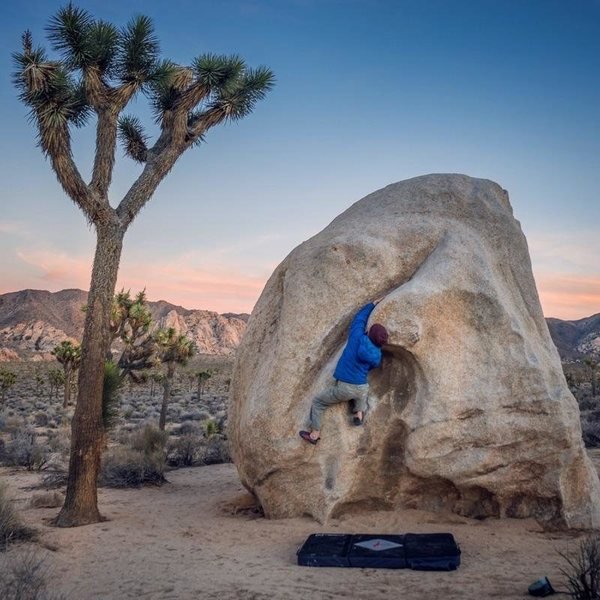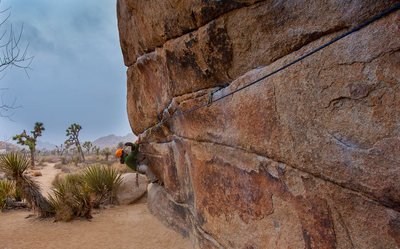First timer's guide to Joshua Tree bouldering
With the colder months approaching, it is now the perfect time to head to the desert and boulder in one of America's best climbing spots
By Mariana Duran
Joshua Tree's landscape is dotted with Dr. Seuss style cacti and huge boulders strewn about that attract climbers from all over the world with 8,000 climbing routes and 2,000 bouldering routes.
Bouldering is a stye of climbing that relies on protection from pads on the ground instead of climbing ropes and harnesses. While it can technically be done at anytime during the year, it is recommended to only boulder in Joshua Tree during the colder months in order to avoid the scorching temps during the summer.
It is common for people to get their start in rock climbing through bouldering first since the only items needed to get started are a crash pad, chalk and climbing shoes. It is significantly less expensive to get started bouldering in comparison to more gear-focused styles such as lead or traditional climbing where protection is placed as the climber ascends.
Luckily, all the gear needed can also be rented at Joshua Tree outfitters.
There is no gas or water for purchase in the park, so be sure that all necessities are ready to go to ensuring a comfortable stay in the desert.
To reach the park from the Inland Empire, take the I-10 and exit 117 for CA highway 62 towards twenty-nine palms/Yucca Valley. This gives access to both the west and north entrance of the National Park where a $30 fee is collected.
While a trip to Joshua Tree can be done in a day, it can be more enjoyable to spend at least two days in the park by snagging a spot at one of the many campgrounds. The most popular accessible grounds to nearby boulders are Hidden Valley campground, Jumbo Rocks campground and Ryan campground.
However, several of the sites at these campground have boulder problems, therefore, it is advised to always ask other campers before climbing a boulder that is on their site.
The app, "Mountain Project," is very useful in locating the precise area of certain boulders thanks to GPS, as well as showing a line representing the intended route and its grade. The grades are used to determine the difficult of the climb with V0 being the easiest, and V17 being the most difficult.
Other users are able to upload photos of the boulders and update the grade after certain sections of the rock have broken off. It also gives climbers a place to keep track of the climbs they have completed.
For those that prefer a more traditional method of finding routes, there are a few bouldering guidebooks that are also regularly used instead. Joshua Tree bouldering, Joshua Tree Rock Climbs, and Classic Joshua Tree Routes and bouldering.
However, since these books are not regularly updated there is no way to know how the boulder problem has changed due to rock chipping or water damage.
Joshua Tree is known as a world class climbing spot, but that does not mean there are not plenty of beginner options to choose from.
Mel's Diner, located in the Lost Horse North area, is an excellent beginner-friendly area. This tends to be one of the less popular crags and is a great place to warm up with several problems with juggy holds ranging from V-easy to V4. While you should always use a crash pad when bouldering outside, it is not uncommon to see climbers not using any because the problems here tend to be very easy and not too high off the ground.
Cap Rock, located in the center of the park, is one of the more popular crags as the problems here tend to be harder. However there are seven V0 routes in this area that can definitely take up some time, especially when new to bouldering.
The Gunsmoke traverse in the Barker Dam is another fun route to try since it requires an 80-foot horizontal traverse. It is graded at a V3, however it is possibly considered beginner-friendly because of how low to the ground it is.
There are thousands of routes to choose from in Joshua Tree. These are some of the most popular areas to first start out on especially since many of the boulders have easy access off the rock once the top has been reached.
One thing that is often struggled with when bouldering is finishing a route, topping out and realizing there is not an easy way down where panic can start to set in.
With the desert climbing season just now beginning again, it will not be uncommon to find hundreds of climbers flocking to the park daily to get on the rocks. One does not have to be an expert climber to get started with outdoor bouldering and with the help from Mountain Project or guidebooks, something can be found for everyone at any stage in their climbing journey.



